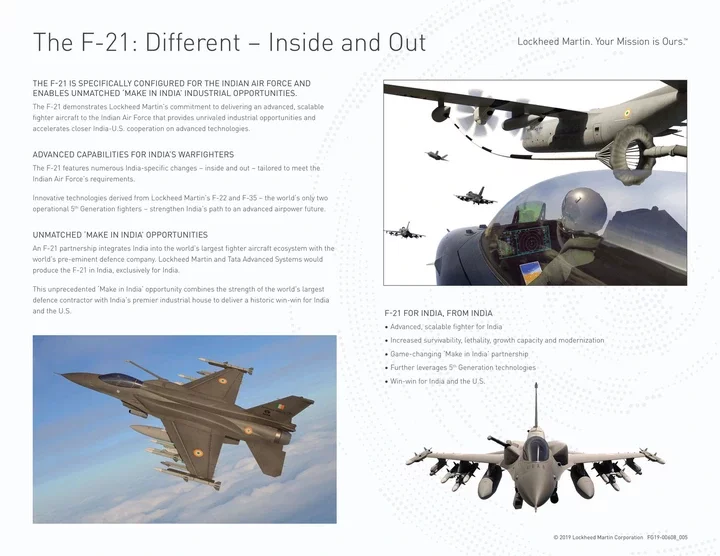Lockheed Martin's proposal for the Indian Air Force to use the F-21 fighter jet has important implications for the air power of the Indian Air Force (IAF). This would change India's aerospace development and national defense industry across the board. The F-21 concept offers a chance to develop in-house engineering expertise, bolster domestic manufacturing capabilities, and craft a platform that is tailor-made for India's strategic needs. Its technical details, role in the IAF, and broad impact of co-production can all be combined to highlight how this offer might boost India's defense posture as a whole.

Photo: Lockheed Martin
The Lockheed Martin F-21 comes from the F-16 Fighting Falcon family tree, a fighter that has been flown by many air forces around the world for decades. This new model seeks to integrate fifth-generation avionics, sensor fusion technologies, and open system architectures to meet emerging operational demands. The F-21 is designed to be suited for India's specific tactical and strategic theater of ops. This proposal looks beyond introducing a new aircraft to developing a framework of defense industrial strength.

Photo: Lockheed Martin
According to Lockheed Martin, the F-21 would feature the specifications akin to the F-16 Block 70/72 that is based on:
• Wingspan: 31 ft/9.45 m
• Length: 49.3 in/15.09 m
• Height: 16.7 ft/5.09 m
• Maximum Takeoff Weight: 48,000 lb/21,772 kg
• Maximum Speed: 1,500 mph/2,414 kmh
Collaboration and shared success
At the beginning, Lockheed Martin's F-21 program brief goes into the industrial partnership as opposed to a standard export transaction. As part of the agreement would be technology transfer and component production domestication. Even F-21 full assembly in India is on teh table as an option under the deal. In the future, such a partnership will reduce Indian over-dependence on foreign sources and simultaneously encourage the development of the aerospace industry in India. Local firms can gradually acquire the knowledge and capabilities for maintaining, enhancing, and modifying advanced tactical aircraft to fit future needs.

Photo: Lockheed Martin
Eurasian Times reported that the F-21's design and capabilities place it closer to more sophisticated fifth-generation fighters, akin to the F-22 Raptor. The aircraft may not be classified as 5th or 6th generation, but with features like sensor fusion, avionics, and an advanced pilot interface, it is much more advanced than any other fourth-generation aircraft, including the F/A-18E/F Super Hornet.
Modernization without compromise
The way a new platform integrates into the current fleet structure must be carefully considered before it is introduced. Each of the platforms that the IAF currently uses, both domestic and foreign, has different logistical, training, and doctrinal requirements. Using the F-21 would require integrating weapons and sensors, changing supply systems, and retraining troops without putting undue strain on the air force's operational readiness. Whether the F-21 can improve overall force posture while seamlessly integrating into current operations is the question.

Photo: Lockheed Martin
Financial Express suggests that the F-21, by virtue of its capabilities and adaptability, could dramatically improve the air force's ability to handle multiple threats simultaneously. Airspeed, operational range, and electronic systems are important, but it's the capability to integrate with the wider network of monitoring and data-networking that is truly significant. The National Interest also observed that the F-21 would also alter regional perceptions of India's airpower. The F-21's design would enhance interoperability and serve as a foundation for more cohesive combat strategies.

Photo: Lockheed Martin
On the Tata advanced systems webpage, they made the following statement in reference to the F-21 program: "The F-21 Block 70 is ideally suited to meet the Indian Air Force's single-engine fighter needs and this unmatched US-Indian industry partnership directly supports India's initiative to develop private aerospace and defense manufacturing capacity in India. This unprecedented F-21 production partnership between the world's largest defense contractor and India's premier industrial house provides India the opportunity to produce, operate and export F-21 Block 70 aircraft, the newest and most advanced version of the world's most successful, combat-proven multi-role fighter. F-21 production in India supports thousands of Lockheed Martin and F-21 supplier jobs in the US, creates new manufacturing jobs in India and positions the Indian industry at the center of the most extensive fighter aircraft supply ecosystem in the world."
The long view
Its potential as a long-term platform for ongoing development is one of the more exciting features of the F-21 plan. An airplane can adopt new technology through modularity, open architecture frameworks, and incremental upgrades. As radar systems, sensors, and missiles develop over decades, a platform that can adapt to these changes is still useful. By selecting a system that does not constrain it into fixed configurations, India paves the way for an air force that can adapt to new threats without needing complete overhauls.

Photo: Lockheed Martin
Choosing a platform such as the F-21 would not occur in a vacuum. India has recently added the Dassault Rafale to its fleet, continues to depend on the Su-30MKI, and is in the process of developing its own Tejas fighter. Every new acquisition should be assessed not just by its capability metrics but also by how well it enhances current assets. The balancing act entails logistics, training, budget limitations, and strategic perspective. India needs to evaluate how the F-21's potential for local industrial involvement and future flexibility compares to other proposals or domestic development options.

Photo: Lockheed Martin
Last but not least, the Lockheed Martin F-21 is more than just an airplane. It represents a possible change in India's long-term airpower strategy configuration, domestic aerospace industry development, and defense technology acquisition. Together, the industrial promises, strategic concerns, and requirements form a larger story. India could go closer to its goal of increased autonomy, industrial depth, and operational effectiveness if the F-21 is selected. How well the proposed agreement fits with India's long-term strategic, economic, and technological goals will determine the final decision.

















Comments